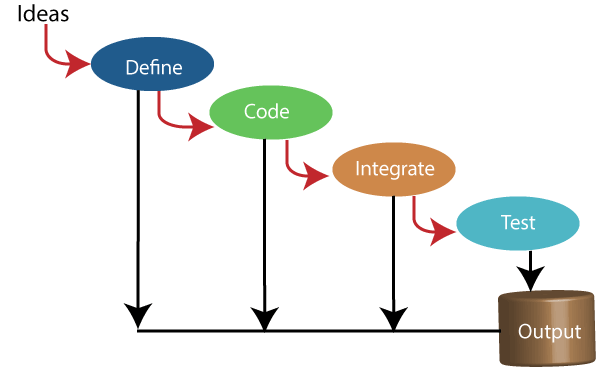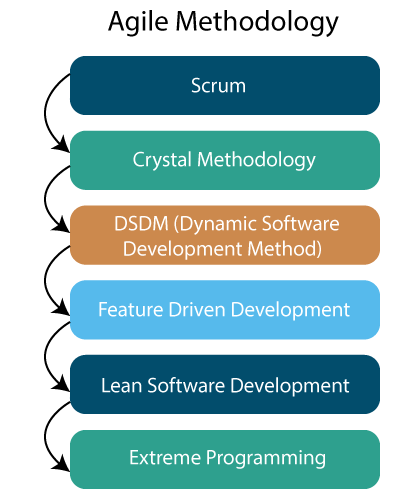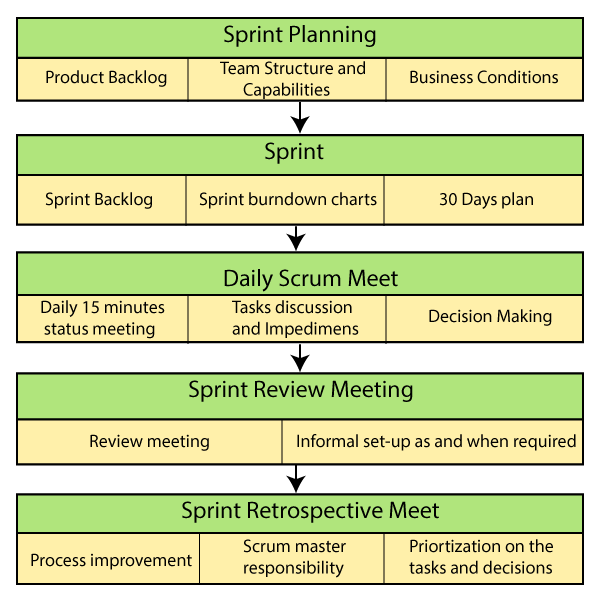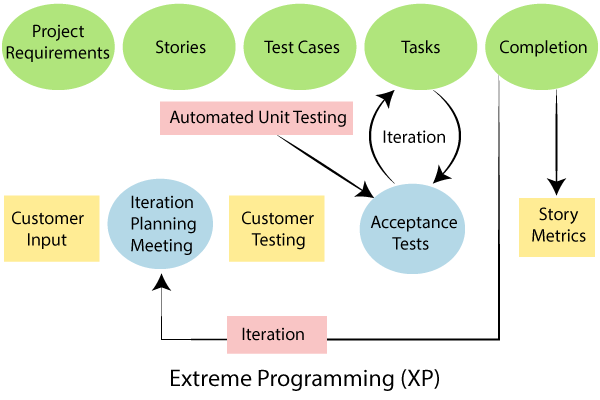Agile Methodology Tutorial
Index
- Introduction to Agile Methodology
- What is Agile Methodology?
- Agile Element
- Agile Principle
- Phases of agile Methodology
- History of Agile Methodology
- Features of Agile Methodology
- Advantages and Disadvantages
- Agile Methodologies
- Scrum
- Crystal Methodologies
- DSDM (Dynamic Software Development Method)
- FDD (Feature driven Development)
- Lean Software Development
- XP (Extreme Programming)
- Kanban
- Conclusion
Introduction to Agile Methodology
Agile Methodology is one form of software development methodology. Its primary focus is on the continuous delivery of customer satisfaction. The focus of agile is more on controlling the project scope. The Agile plan sets minimum requirements and transforms them into a service that can be implemented.
What is Agile Methodology?
Agile Methodology is a technique that supports continuous development iteration and validation throughout the project's life cycle of software development. Unlike the Waterfall design, development and testing activities are simultaneous.

Agile Methodology is a project management methodology, which arranges projects across four elements and 12 principles. Here is an agile overview of a method and everything you need to know about this Methodology.
Agile Elements
The Agile Manifesto article's four main elements are designed to evaluate, these elements are given below:
1. Individual’s process communications and techniques: - The first value in the Agile Methodology is “Individuals process communication and techniques.” It is easy to understand that people are valued more than processes or resources because it is people who respond to business needs and drive the process of development.
2. Application to work on accurate documentation: - Historically, large amounts of time have been spent on recording the creation and ultimate distribution material. Technical specifications, technical requirements, documents relating to interface design, test plans, documentation plans, and approvals required for each.
3. Customer communication on new contracts: - Negotiation is the process in which the client and the product manager hammer out the delivery details, with points along with how the details can be renegotiated. Collaboration is a different creature entirely. Customers discuss the specifications for the service with concept models such as Waterfall, often in great detail, before any work starts. It means that the consumer shows interest before the development and after development began, but not during the process.
4. Response to modification following a plan:- Traditional design of technology considered a change to be an expense, so should be avoided now. The goal is to create detailed, elaborate plans, with a given set of features and with everything, usually having as high a priority as everything else, and with a large number of delivery dependencies in a particular order so that the team could focus on the next piece of the puzzle.
Agile Principles
The Agile Manifesto article's 12 main principles are designed to evaluate:
1. Our highest priority is to support the customers through providing useful software early and consistently: The Agile Methodology's first principle states that customers should receive project deliverable or prototypes at frequent intervals during the project life, rather than just one product delivery at the end.
2. Welcome customer requirements, even early in development, Agile processes change activate for the competitive advantage of the customer: One of the difficulties Manifesto authors found with traditional project management was that customer applications for last-minute change were difficult to satisfy. But now, Agile projects will adapt to any changes with minimal delay, no matter how late in the process.
3. Frequently produce working code, from a few weeks to a few months, with a preference for the shorter time-frame: Agile projects are planning frequent, short project timelines allowing a good result of workable products. Sometimes, Agile projects are separated into sprints or task cycles of 1 to 4 weeks, each resulting in the delivery of a service.
4. Across the whole project, business, people, and designers will work together every day: The Agile principle states that frequent interaction is critical to the success of the project with all stakeholders. It usually involves a short regular meeting with the project team as well as any other key stakeholders.
5. Create projects among peoples who are driven. Offer them the environment they need and support, and trust them to do the job: A vital concept of the technique of Dynamic software development is that the right people should be placed in the right positions and given the flexibility they need to do their jobs well. Developing a project team based on skills is critical rather than job positions or company names. The project manager must concentrate on inspiring and helping the project team rather than micromanaging them.
6. Face-to-face communication is the most efficient and effective way of transmitting information to and within a development team: The Agile Manifesto developers firmly believe in the importance of co-locating organizations and stakeholders whenever possible, because face-to-face interaction is more effective than other methods like email or phone. If you cannot co-locate your group, video conferencing is an alternative that can still capture some of the same quality, such as non-verbal signals.
7. The primary measure of progress is working code: The Agile Methodology's focus is on achieving completed, functional outcomes. This should also take precedence over any additional requirements, such a documentation of the design. Such metrics, such as hours spent or time elapsed, are also not considered as necessary as the availability of work materials.
8. Agile systems are supporting sustainable development. A constant pace should be maintained indefinitely by sponsors, developers, and users: Agile projects should have a consistent speed within the design for each iterative process or Sprint according to this theory. This failure would remove the need for overtime or plans to crash while encouraging the regular production of workable goods. It should also create a repeatable loop that can be followed as long as necessary by the group continuously.
9. Continuous emphasis on technical excellence and good design increases agility: An Agile project will focus primarily on improving the end product and making progress over time. In other words, each iteration should always be an improvement over the previous iteration, and the team should always seek new ideas.
10. Simplicity is essential – the art of minimizing the amount of work that is not completed: The goal of the agile project is to do just enough to complete the requested project successfully and to conform to the required specification. Any additional documentation, steps, processes, or work that does not add value to the customer or improve the outputs of the project should be avoided or removed.
11. Write down anything you want to paraphrase it, press the Quill It button on the right: Agile is based on the belief that to deliver the best results and goods, inspired, autonomous, and skilled teams are needed. Units should be encouraged to organize themselves and structure when appropriate. They should be able to collaborate and innovate as they see fit, without too much control being impeded.
12. The group is focusing on how to become more successful at regular intervals, then tuning and adapting its behavior accordingly: A successfully, self-motivated team requires a strong emphasis on how to continue to grow & improve their skills and processes. The group must review their progress and outcomes regularly, including exploring how they can develop as they move forward.
Phases of Agile Methodology
There are six phases in agile Methodology:
- Concept
- Inception
- Iteration
- Release
- Production
- Retirement
Concept: - Based on value, programs, and feasibility, denoted envisaged, and prioritized.
Inception: - A team is set up, team members are identified individually, a fund is set up, and any initial requirements are discussed and decided upon.
Iteration: - The project team starts to work on the development of the project using code applied with the agile approach based on the needs for refinement and input.
Release: - Quality monitoring, training, both internal and external, and the development of information and reporting.
Production: - The Agile approaches help to keep track of your plan and ensure that it is continually optimized and able to recover from any sudden changes or difficulties.
Retirement:- Activities at the end of life.
History of Agile Methodology
- The history of the agile technique can be traced back to the 1990s, 1975s, and the 1960s. However, everybody acknowledges that with the development of the Manifesto for Agile Software Development, published in 2001, Agile has taken root.
- Initially it was created on February 2001, the Agile Report created a new way to manage software development. This report was the result of a conference in Utah, where a group of leading developers of software met to discuss problems and potential solutions to the industry.
- This group of individuals acknowledged that a better way to get products to market quicker was necessary by the software industry. They aimed to develop new strategies for modifications in product and plan without significantly affecting the cost of the project or slowing the pace of development.
- It was decided that a design could be developed and tested easily and quickly by dividing iterations into shorter iterations.
Features of Agile Methodology
There are Multiple Features of Agile Methodology
- Iterative
- Modularity
- Time Boxing
- Parsimony
- Incremental
- Adaptive
- Convergent
- Collaborative
- People-Oriented
Iterative
The main goal of agile application systems is customer satisfaction, so with multiple iterations, it focuses on a single requirement.
Modularity
The agile cycle breaks down the entire system into manageable components. Modularity plays a significant role in the processes of software development.
Time Boxing
As an agile method is iterative, each module with its respective duration needs time limits.
Parsimony
In agile systems, parsimony is provided by a minimum number of modules to mitigate risks and achieve the goals.
Incremental
Since the agile Methodology is iterative in nature, it involves gradual creation of the system, where, each increment is independent of others, and eventually, all increases are merged into the whole system.
Adaptive
Since the agile method is iterative, it involves incremental creation of the program. Every increment is independent of others, and eventually, all increases. Because of the iterative nature of the agile process, new risks may arise. The flexible feature of the Agile system enables the systems to be modified to meet the latest threats and allows changes in the requirements of real-time.
Convergent
By using iterative and gradual strategy, all the risks associated with each increase are concurrent in the active phase.
Collaborative
Because agile approaches are versatile, the software development team needs excellent communication. At the end of the software development process, separate modules must be combined.
People-Oriented
Customer satisfaction in Agile systems is the first concern over software and procedure. A good software development team improves the software's quality and profitability.
Advantages of Agile Methodology
- The delivery of technology is unwavering in the agile approach.
- The customers are pleased because agile methodology is supplied with every sprint functionality of the application.
- Customers can look at the functionality that satisfies their standards.
- If the clients have any suggestions or design improvements, they can be accommodated in the product's current release.
- The regular communications between people in business and programmers are needed in the agile Methodology.
- Attention was paid in this approach to the product's sound design.
- Even in the later stages of development, improvements in specifications were acknowledged.
Disadvantages of Agile Methodology
- The requirement is sometimes not entirely evident in the agile technique, so it is difficult to predict the expected result.
- It is difficult to estimate the actual efforts involved in a few of the projects at the beginning of the life cycle of software development.
- Projects that implement the agile technique can face unknown risks that may impact the project.
Agile Methodology

There is various methods in agile, and these are following.
Scrum
SCRUM is an agile model of design that primarily focuses on how to manage tasks in a team-based software platform. Scrum is generally derived from an activity that takes place during a rugby match. Scrum is committed to empower the development team and support working in small groups (say- 7-9 members). It consists of three tasks, and they describe their duties as follows:

- Scrum Master
A leader is in charge of designing the group, sprinting, and eliminating challenges to progress.
- Product owner
The Product owner maintains a software backlog, prioritizes the delay, and is responsible for the functionality delivery at each iteration.
- Scrum Meeting
The team manages its work and organizes the Sprint and cycle work.
- Prepare Product Backlog:
It is a database where requirements are monitored for each release with information about the requirements (user stories) to be completed. Product Owner must manage and organize it and distribute it to the scrum team. A new condition may also be required by the organization to be changed or removed.
How Scrum Works
Step 1: For each Sprint, the product owner creates a new set of features identified in the product backlog.
Step 2: Then, the team chooses the top attribute from the backlog of the service to be shipped at the start of a sprint.
Step 3: The function gets split into a smaller project that is created by the brand owner found in the sprint backlog after deciding to do a particular feature.
Step 4: Then the Sprint begins, there is a so-called regular meeting during the Sprint, where the member of the team shares their task status and addresses a task related issue.
Step 5: After the Sprint has been completed, the feature will be submitted for approval to the brand owner, and the feedback will be given to the sprint feedback team relevant to an element.
Step 6: Eventually, the scrum master and brand owner address progress in the overall process in a retrospective session with the group. The project is split into a smaller task that is created by the brand owner found in the sprint backlog after deciding to do a particular feature.
Process flow of Scrum Methodologies
Process flow of scrum is as follows:
- Each iteration of a scrum is named as Sprint
- Project backlog is a list that includes all the information to procure the end product.
- Top consumer stories of the Service Backlog were picked during each Sprint and translated into Sprint Backlog
- The team works on the established sprint backlog
- Team reviews for everyday work
- The team delivers product features at the end of the Sprint
The Dynamic Software Development methods are
- Time Boxing
- Moscow Rules
- Prototyping
Scrum Practices

Crystal Methodology
Though essential, the process should be considered as a secondary focus after the above. The concept behind the Crystal Methods is that the teams involved in software development will usually have varied sets of skills and talent, so the Process aspect is not a significant factor.
There are three concepts in the crystal methodology:
- Chartering: - Different activities in this process include forming a development team, carry out a conceptual feasibility analysis designing an initial plan, and finalizing the design methodology.
- Cyclic delivery:-The main phase of development consists of two or more production phases during which the output is carried out.
- The team improves and refines the release plan.
- Implement a sub-set of requirements by combining iterations of one or more software tests.
- It provides an integrated service for real users.
- Discussion of the project plan and strategy for growth.
- Wrap Up: - The operations carry out in this process are user implementation, sub-deployment evaluations, and reflections are carried out.
DSDM (Dynamic Software Development Method)
Dynamic Software Development Method is a RAD (Rapid Application Development) Methodology Software development and creates an agile project framework for production. DSDM (Dynamic Software Development Method) important element is that customers need to be actively involved, and the teams have the power to make decisions. For DSDM, consumer delivery is the current priority. DSDM has 7 stages, which are given below:
- Min Project
- Feasibility Study
- Analysis of business
- Iteration of the logical framework
- Model and build variation
- Execution
- Max Project
FDD (Feature Driven Development)
This method focuses on the features of "design & create." In compared to other agile methods, FDD defines very specific and fast phases of work to be done individually per function. This requires domain preview, analysis of software, promotion of building, analysis of code, and design.
FDD (Feature Driven Development) creates a service that keeps things in the goal.
- Modeling of the domain object
- Implementation by feature
- Ownership of the component/class
- Function Concepts
- Inspections
- Operation of configurations
- Normal building
- Visibility of success and results
Lean Software Development: - Lean software development approach is based on the "Just in Time Production" concept. This aims to increase software development speed and decrease costs.
Lean development can be summarized in seven stages
- Removal of waste
- Enhancing training
- Defer communication (decide as early as possible)
- Sending first
- Enabling the system
- Creating Quality
- Optimize the complete package
Extreme Programming (XP)
Extreme programming methodology is beneficial when clients ' demands or expectations are continually changing or if they are not sure about the system's functionality. This supports regular product releases in short development cycles, which ultimately increases the system's competitiveness and also provides a checkpoint where any consumer demands can be easily implemented.
The XP creates customer-friendly applications.

In terms of tales, company criteria are gathered. All these stories are stored in a parking lot spot.
Releases based in this form of technique on the shorter intervals are called Iterations with a period of 14 days. - Iteration involves phases such as coding, unit testing, and system testing, where some minor or significant features are integrated into the software at each stage.
Extreme programming phases
There are 6 phases in Agile Extreme programming, which are as follows:
1. Planning
- Identification of supporters and investors
- Guidelines for services
- Data and compilation related to security
- Agreements on service level and its terms and conditions
2. Analysis
- Stories are found in the parking lot
- Prioritize Parking lot tales
- Scrubbing of projected accounts
- Defines SPAN(Time) Iteration
- Resource preparation for development teams as well as QA teams
3. Design
- Dismantling of activities
- Preparation of the evaluation scenario for each project
- Framework for Regression Automation
3. Execution
- Programming
- Testing of units
- Manual research conditions are performed
- Generation of records of defects
- Conversion of Test Regression Manual to Automation
- Study of mid-term iteration
- Discussion of the start of the iteration
4. Wrapping
- Limited publications
- Analysis of regression
- Demos and feedback
- Develop new needs-based stories
- System Changes based on comments from the beginning of the iteration analysis
5. Closure
- Release of the pilot
- Education
- Start of production
- Assurance of the SLA
- Study the approach of the SOA
- Help for the output
Two storyboards are available to track the work daily, and those for comparison are listed below.
- The carton of the story
This is a typical way to collect all the stories in a board in the form of stick notes to record XP events daily. It is better to switch to an online form because this manual task requires more effort and time.
- Storyboard online
Storyboard online tools can be used to store the stories.
Kanban
Initially, Kanban originated from the Japanese word meaning a card with all the details needed to be done on the item at each point along its journey to completion. In software testing method, this system or method is quite adopted, particularly in agile testing.
Conclusion
Agile models are based on the creation of iterative code. After the iteration is completed, an independent working unit is installed. Repetition is not required to complete code for more than two weeks. Instead of a separate quality assurance group, agile methodologies allow developers to participate in training.
Due to new methods and concepts that allow a team to develop a product in a short duration, agile methodologies are perfect for changing environments.